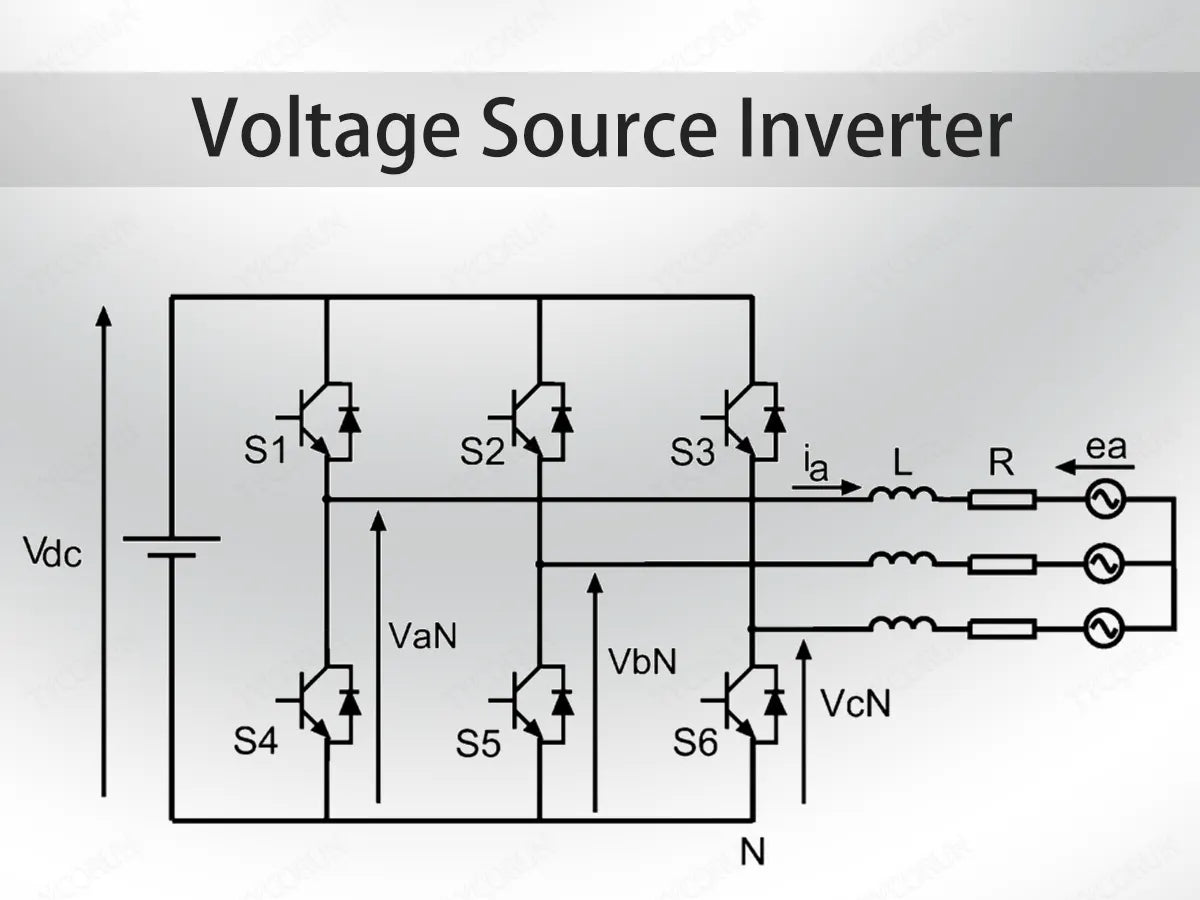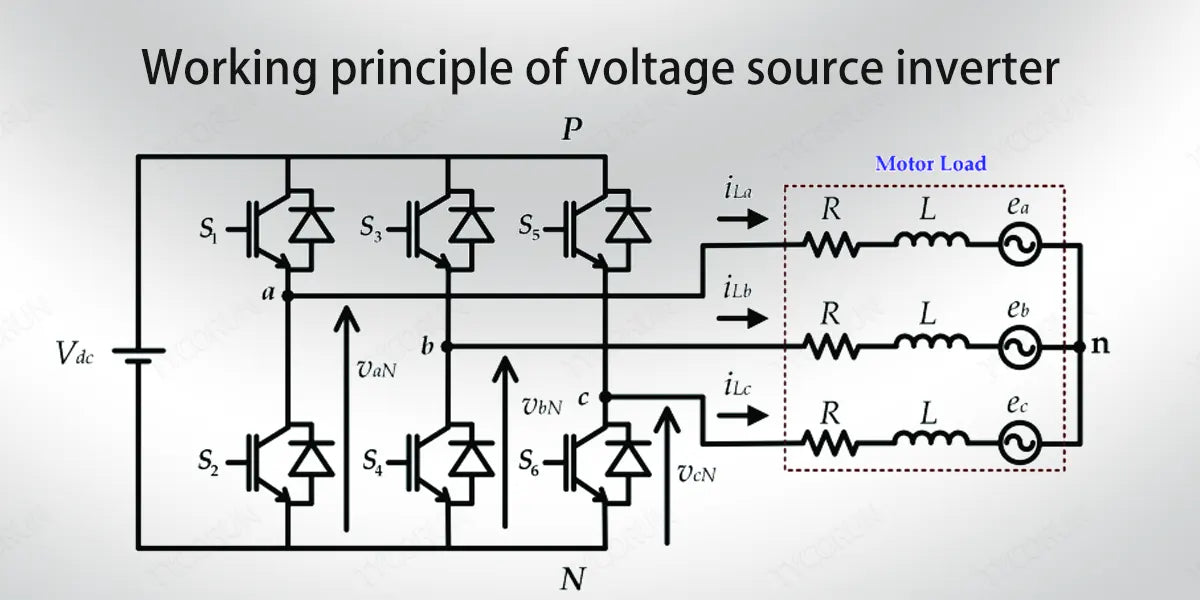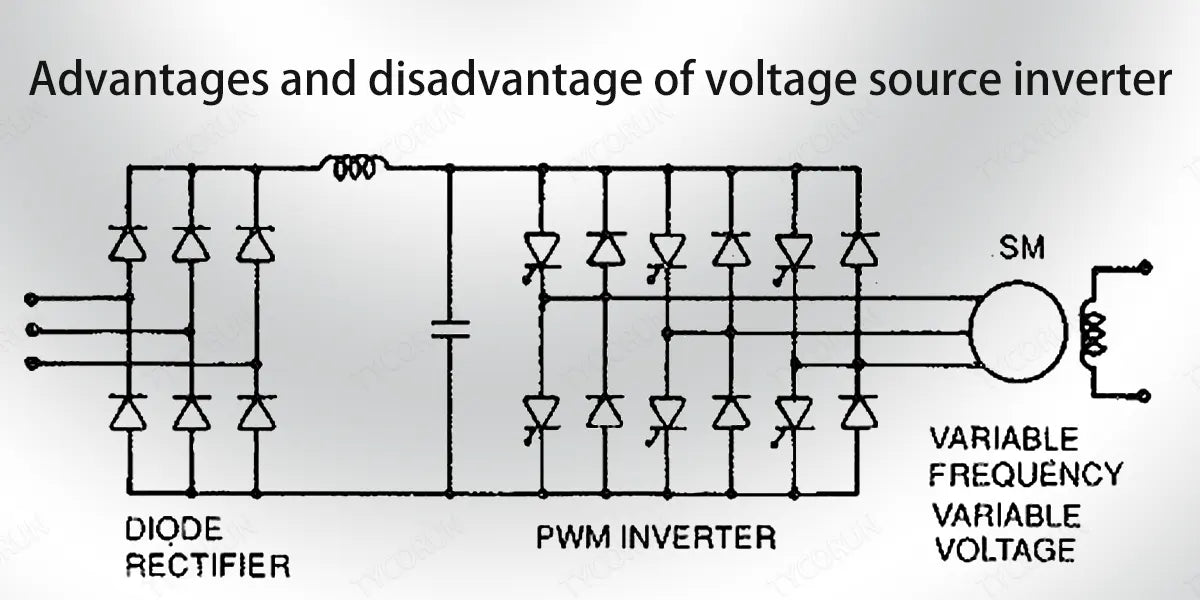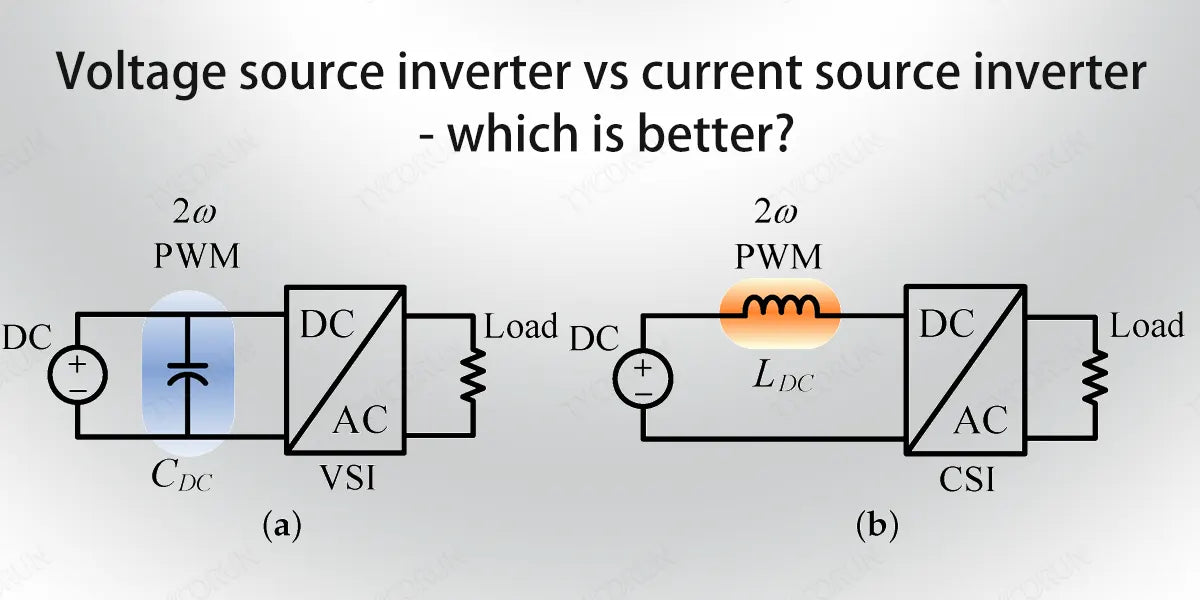
In the intricate tapestry of power electronics, the voltage source inverter (VSI) stands as a cornerstone, facilitating the conversion of direct current into alternating current.
In this post, we will delve into the fundamental aspects of voltage source inverters, exploring their workings, advantages, disadvantages, applications, and the unique offerings of Tycorun in the realm of power solutions.
Main content:
- What is the voltage source of an inverter?
- Working principle of voltage source inverter
- Advantages of voltage source inverter
- Disadvantages of voltage source inverter
- Application of voltage source inverters
- Difference between voltage source inverter and current source inverter?
- Voltage source inverter vs current source inverter - which is better?
- Tycorun voltage source inverter - how to choose the size?
- FAQs
1. What is the voltage source of an inverter?
Voltage source inverter does not need output current sensor, the control system only needs voltage feedback signal to realize high-precision control of the output waveform. Therefore, the voltage source inverter is characterized by fast response speed and good control performance.
The voltage source within an inverter is typically derived from a stable DC power source such as a battery or a solar panel. The steady DC voltage is then modulated to produce an AC output, allowing for the versatile use of electrical devices requiring alternating current.
2. Working principle of voltage source inverter
The working principle of a voltage source inverter revolves around the utilization of semiconductor switching devices to modulate the DC input voltage into a controlled AC output. Commonly employed switches, such as insulated-gate bipolar transistors (IGBTs), play a pivotal role in shaping the AC waveform, enabling precise control over the frequency and magnitude of the output voltage.
The process begins with the DC power source supplying a continuous voltage. This voltage is then manipulated through the controlled switching of the IGBTs, creating a pulse-width-modulated (PWM) signal that approximates a sinusoidal AC waveform. This PWM signal is subsequently filtered to achieve a smooth and continuous AC output.

3. Advantages of voltage source inverter
Voltage source inverters offer several advantages that contribute to their widespread adoption in diverse applications:
- Precise control: VSIs allow for precise control of output voltage and frequency, making them suitable for applications demanding accuracy.
- Efficiency: They exhibit high efficiency in converting DC to AC power, minimizing energy losses during the conversion process.
- Versatility: VSIs can cater to a wide range of applications, from powering household appliances to driving industrial machinery.
- Compatibility: They seamlessly integrate with various power sources, including batteries, solar panels, and other DC supplies.
- Reliability: Voltage source inverters are known for their reliability, ensuring a stable and consistent AC output under varying load conditions.

4. Disadvantages of voltage source inverter
While VSIs offer numerous advantages, they come with some limitations:
- Complexity: The intricate electronic components and control mechanisms can contribute to the complexity of VSIs.
- Harmonic distortion: In certain scenarios, voltage source inverters may introduce harmonic distortion in the AC output waveform, potentially impacting connected devices.
- Cost: The sophisticated technology employed in VSIs can lead to higher manufacturing and maintenance costs.
- Heat generation: During operation, voltage source inverters can generate heat, necessitating effective cooling mechanisms like inverter fan to maintain optimal performance.
5. Application of voltage source inverters
Voltage source inverters find application across a broad spectrum of industries and sectors, showcasing their versatility and adaptability:
- Renewable energy: VSIs play a pivotal role in converting the DC output of solar panels into grid-compatible AC power, facilitating the integration of solar energy into the power grid.
- Motor dives: They are commonly employed in variable frequency drives for electric motors, offering precise control over motor speed and torque.
- Uninterruptible Power Supplies (UPS): VSIs provide a reliable source of AC power during grid outages, ensuring uninterrupted operation of critical systems such as data centers and medical facilities.
- Grid-tied systems: VSIs are utilized in grid-tied systems where renewable energy sources, such as wind or solar power, are connected to the electrical grid.
- Portable power: Whether you're camping or on the go, the voltage source inverter converts DC power from batteries into AC power for a variety of AC devices.
6. Difference between voltage source inverter and current source inverter?
The difference between voltage source inverter and current source inverter is mainly manifested in four aspects: energy conversion method, control method, output waveform and applicable scenarios.
- Different energy conversion methods Voltage source inverters use semiconductor switching devices to convert DC to AC, while current source inverters convert DC to AC through power modules, control circuits, filtering circuits and so on.
- Different control methods Voltage source inverter adopts PWM pulse width modulation control method, while current source inverter adopts current control method.
- Different output waveforms Voltage source inverter outputs precise sinusoidal waveform, while current source inverter outputs waveform with high-precision current control and over-current protection.
- Different application scenarios Voltage source inverters are suitable for high-quality power loads, including computers, office equipments, medical equipments, precision instruments, etc., while current source inverters are suitable for high-power power systems, including industrial robots, electric motors, electric-driven cars, etc.

7. Voltage source inverter vs current source inverter - which is better?
Voltage source inverters come in various configurations, with two prominent types being the Voltage Source Inverter (VSI) and the Current Source Inverter (CSI). Each type has its own set of advantages and limitations, and the choice between them depends on the specific requirements of the application.
- Voltage source inverter (VSI): The VSI is the more commonly used type due to its versatility and efficiency. It modulates the DC input voltage to produce a controlled AC output, making it suitable for a wide range of applications. The precise control over voltage and frequency allows for compatibility with diverse loads.
- Current source inverter (CSI): The CSI, on the other hand, maintains a constant current source at the input and modulates the AC output through the controlled switching of devices. While less common, CSIs find applications in specific scenarios, such as in some motor drives and renewable energy systems.
Between the two types of inverters, the current source inverter is limited in its application because the inductor's low energy storage density results in a larger and bulkier unit than a voltage-based circuit for the same power. In addition, inductors have higher losses than capacitors. Most fully-controlled devices do not have reverse resistance and require diodes to be connected in series, which increases losses and increases the cost of the circuit.
Choosing between a VSI and a CSI depends on factors such as the nature of the load, control requirements, and overall system design.

8. Tycorun voltage source inverter - how to choose the size?
Tycorun, a reputable name in power solutions, offers a range of voltage source inverters catering to diverse power needs. When selecting the size of a Tycorun inverter (ranging from DC to AC converter 500 watt to 3000 watt solar inverter), several factors must be considered:
- Power requirements: Understand the power requirements of the devices you intend to connect to the inverter. Sum up the wattages of all devices to determine the minimum power rating needed.
- Application: Consider the specific application for which the inverter is intended. Different applications may have varying power demands, and the inverter's size should align with those requirements.
- DC power source: Ensure that the DC power source, whether it's a battery or a solar panel, can provide the necessary voltage and current to the inverter.
- Future expansion: If there's a possibility of expanding the system in the future, it's advisable to choose an inverter with some extra capacity to accommodate additional loads.
Tycorun's 12V to 110V/120V inverters provide a reliable and efficient solution for various power scenarios, combining advanced technology with user-friendly features. For more inverter content you can take a look at inverter buying guide, global top 10 best solar inverter brands article, I hope this information can help you.
|
|
500w
|
1000w |
2000w
|
3000w
|
|
Product image
|
||||
|
Price & Discount
|
$49.9(-29%)
|
$98.99(-29%)
|
$199.90(-20%)
|
$229.00(-23%)
|
|
Rated Input Voltage
|
12VDC
|
12VDC
|
12VDC
|
12VDC |
|
Continuous Power
|
500w
|
1000w
|
2000w
|
3000w |
|
Peak Power
|
1000w |
2000w |
4000w |
6000w |
|
More information |
Click to get the details |
Click to get the details |
Click to get the details |
Click to get the details |
9. FAQs
① What is a voltage source inverter also called?
A Voltage Source Inverter is also commonly referred to as a VSI. The term VSI is widely used in the field of power electronics and accurately reflects the inverter's function as a source of controlled voltage.
② Is a solar inverter a current source or voltage source?
A solar inverter is typically a voltage source inverter (VSI) as it converts the DC output from solar panels into grid-compatible AC power. The VSI ensures that the solar power fed into the grid adheres to the required voltage and frequency standards.
③ Why is PWM switching preferred in voltage source inverters?
Pulse Width Modulation (PWM) switching is preferred in voltage source inverters for its ability to control the output voltage and frequency with high precision. It enables efficient control over the power delivery to connected devices, resulting in a smoother and more accurate representation of the desired AC waveform.
Related posts: RV inverter, car inverter near me, top 5 PV inverter companies in India




